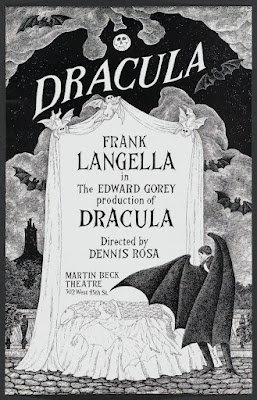Dracula (John Badham, 1979) A Tony Award winning Broadway revival of the 1924 stage version with stage design by Edward Gorey and a much-heralded performance by Frank Langella in the lead* was the inspiration for this late 70's version of the Bram Stoker story. By the time Universal Studios decided to make another version of the play,** Gorey was out, but director John Badham wanted to make the film in black-and-white to better reflect the Broadway version, but the studio wouldn't have it monochromatic.***
The film, adapted from the 1924 Deane-Balderston play by W.D. Richter, would boast some high-end talent. Badham has just come off the success of Saturday Night Fever and he was able to secure Gilbert Taylor as cinematographer, Bond alums Peter Murton as production designer and Maurice Binder—who was experimenting with laser effects at the time—for the title sequence (and as "visual consultant), John Williams (at the time the hottest film composer after his work on Star Wars and Superman) for the score, and the services of Lord Laurence Olivier (during his Germanic acting phase) as co-star.
We skip Transylvania and Castle Dracula and the hapless Jonathan Harker visit to start off with a dark and stormy night, which lashes the unfortunate ship Demeter, bearing a cargo of dead men (and, apparently, a wolf) and sends it into the shoreline of Whitby, Yorkshire. The local head of the sanitarium, Dr. Seward (Donald Pleasence) examines the bodies and determines that all aboard the death ship have had their throats slashed. Mina Van Helsing (Jan Francis)—who is visiting her friend, the doctor's daughter Lucy (Kate Nelligan)—finds that a man has washed ashore, miraculously saving him from the fate of the others. He is Count Dracula (Langella), who has purchased a nearby mansion-in-ruins, Carfax Abbey.Seemingly none the worse for wear, The Count accepts a dinner invitation from Dr. Seward at his residence in the sanitorium. Badham gives him a great entrance where he's announced, strides in and with a perfect flourish takes off his cape and hands it, unseeing, to the butler. Langella's Dracula is handsome, Byronic, and has a way of focusing all his charm through his eyes. Langella also has a condition called nystagmus, which creates involuntary movements of the eye, but here it's an advantage rather than any sort of hindrance; his eyes vibrate in close shots that provide a certain focused attention that seems a bit feral.The evening goes quite well, and if the pairings are uneven, with Lucy Seward attended to by her fiancee, the solicitor Jonathan Harker (Trevor Eve), the Count is only too willing to give his undivided attention to Mina (who looks quite pale). Before too long, she will be dead, and her father Professor Abraham Van Helsing (Olivier) will arrive with questions and a fear that his daughter has joined the Undead. Meanwhile, Dracula turns his attention to Lucy.Where this Dracula has changed over previous incarnations (or reincarnations) is in Dracula's impression as a romantic hunk, as opposed to a creature of the night. Perhaps, it was Hammer's focus on Dracula's effect on the nubile women in those films, or the portrayal of vampire Barnabas Collins as a doomed romantic figure in the 1960's TV soap "Dark Shadows." As opposed to other versions, there were probably a fair amount of audience members who sided with The Count here, rather than with Seward and Van Helsing. Certainly, the character of Lucy has more than sympathy for him, flashing an enigmatic smile at the film's ambiguous ending.
And, as opposed to Hammer, this Dracula can turn into wolves and bats. In fact, Badham stages a shot where Dracula jumps through a window and emerges as a wolf. And there are several instances of "bat-cams" that parallel a prop-bat as it flies through the air. Binder's laser effects seem a bit irrelevant in the scheme of things, like they were tacked on for effect. But, the most unnerving thing about this Dracula is the way he approaches Mina's room early on, the camera looking up the edifice of Seward's hospital to espy the vampire on the roof, and then he moves down the wall like a cat, emerging upside down in the window and flicking away at the molding with his finger nails. Very creepy.
He also seems less vulnerable to crosses and the other religious paraphenalia and garlics Van Helsing uses against him, and as for only appearing at sun-down, he dismisses it entirely: "It's always daylight somewhere on Earth, professor. After my rest, I only need stay in darkness." Good to know. Universal, the studio that released this version—and other iterations of the 1924 play—as part of their promotional material, put out a poster with handy things to know about vampires in order to "know the facts." I can hear the voice of Agent Scully saying "Well, first, they don't exist..."
All in all, it's not bad. A little hysterical. A little silly. A literal bodice-ripper. But, at least it's a record of Langella's approach to the character from his Broadway run. And there's gratitude for that.* When Langella left the production, Raul Julia took over. In the touring version, Jeremy Brett and Jean LeClerc played Dracula.
** Universal had a major hit (and franchise) with the Bela Lugosi version in 1931. Before the Langella-Gorey run, the previous Broadway performer had been...Bela Lugosi. While the novel is in the public domain (which is why Francis Coppola could make a film of it) Universal owns the film rights to the play, commissioned by the Stoker estate to combat imitations...like Murnau's Nosferatu .










No comments:
Post a Comment